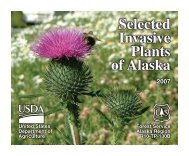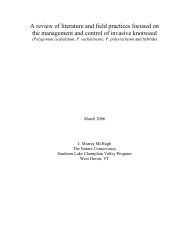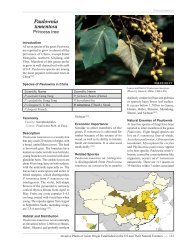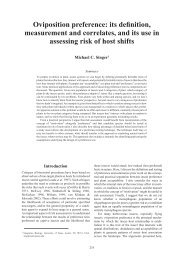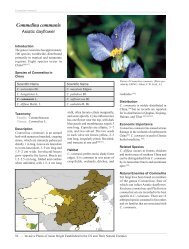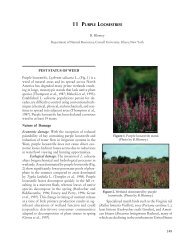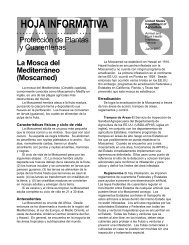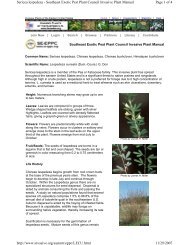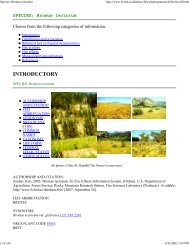The Biology of Tectococcus ovatus Hempel ... - Invasive.org
The Biology of Tectococcus ovatus Hempel ... - Invasive.org
The Biology of Tectococcus ovatus Hempel ... - Invasive.org
You also want an ePaper? Increase the reach of your titles
YUMPU automatically turns print PDFs into web optimized ePapers that Google loves.
Proceedings <strong>of</strong> the X International Symposium on Biological Control <strong>of</strong> Weeds<br />
4-14 July 1999, Montana State University, Bozeman, Montana, USA<br />
Neal R. Spencer [ed.]. pp. 651-657 (2000)<br />
<strong>The</strong> <strong>Biology</strong> <strong>of</strong> <strong>Tectococcus</strong> <strong>ovatus</strong> <strong>Hempel</strong><br />
(Heteroptera: Eriococcidae) and its Potential<br />
as a Biocontrol Agent <strong>of</strong> Psidium cattleianum (Myrtaceae)<br />
MARCELO D. VITORINO 1, JOSÉ HENRIQUE PEDROSA-MACEDO 2 ,<br />
and CLLIFORD W. SMITH 3<br />
1Av. República Argentina, 2534 Apto 14-A, Bairro Portão,<br />
Curitiba-PR, Brasil, CEP: 80610-260<br />
2 Engenharia Florestal, DSM/SCA – Universidade Federal do Paraná<br />
Av Pref. Lothario Meissner, 3400 80210-170 Curitiba, Paraná, Brazil<br />
3 Department <strong>of</strong> Botany, University <strong>of</strong> Hawaii at Manoa<br />
3190 Maile Way Honolulu, Hawaii 96822, USA<br />
Introduction<br />
<strong>The</strong> great diversity <strong>of</strong> the South American flora has interested botanists and agronomists<br />
for more than 200 years. Many species have been introduced to other tropical and<br />
subtropical areas. Some <strong>of</strong> the introductions have been <strong>of</strong> considerable agricultural or horticultural<br />
importance, e.g., pineapple Ananas comosus (Bromeliaceae), rubber Hevea<br />
brasiliensis (Euphorbiaceae), but others have become major pests, e.g., araçá (Brazil) or<br />
strawberry guava (elsewhere) Psidium cattleianum Sabine (Myrtaceae), Brazilian peppertree<br />
Schinus terebinthifolius Raddi (Anacardiaceae), water lettuce Pistia stratiotes L.<br />
(Araceae), tropical soda apple Solanum viarum Dunal (Solanaceae) (VITORINO, 1995).<br />
Strawberry guava is native to the Atlantic forest ecosystem <strong>of</strong> Southeastern Brazil. It<br />
occurs as a major component <strong>of</strong> the coastal restinga vegetation and as an occasional<br />
understory tree in the forest up to 1300 m elevation. It is common in disturbed areas frequently<br />
invading abandoned fields. It is a highly variable species whose taxonomy has<br />
been the subject <strong>of</strong> some considerable uncertainty (FOSBERG, 1971). <strong>The</strong>re are at least<br />
three forms commonly agreed upon: a tree up to 10 m tall with elliptical, yellow fruit; a<br />
shrub rarely above 5 m with round, red fruit; and a form similar to the red but with yellow<br />
fruit. <strong>The</strong> size <strong>of</strong> the red- and yellow-coloured fruit is the same but the yellow-fruit<br />
have fewer larger seeds than the red form. In Brazil, the red-fruited form is confined to<br />
elevations above 900 m and is quite rare, whereas the yellow-fruited form is found<br />
throughout the range <strong>of</strong> the species.<br />
Strawberry guava was introduced to Hawaii by a priest around 1820 as a table-fruit<br />
but soon escaped and is now considered the most important weed in Hawaii (SMITH,<br />
1985). <strong>The</strong> absence <strong>of</strong> natural enemies, its ecological plasticity, the high level <strong>of</strong> disturbance<br />
in abandoned agricultural areas, the synergism between feral pigs and strawberry<br />
guava DIONG, (1982) and its use in Japanese garden landscaping all contribute to the wide<br />
dispersion <strong>of</strong> this plant in Hawaii. Similar factors have contributed to its invasiveness<br />
elsewhere.<br />
In 1990, a survey <strong>of</strong> the associated entom<strong>of</strong>auna <strong>of</strong> strawberry guava around Curitiba-<br />
PR, Brazil, identified five species <strong>of</strong> potential biological control agents WIKLER et al.,<br />
(1993). Among them, leaf galls induced by <strong>Tectococcus</strong> <strong>ovatus</strong> <strong>Hempel</strong> (Heteroptera:<br />
651
652<br />
Vitorino et al.<br />
Eriococcidae) was readily manipulated in the laboratory. This coccid appeared to satisfy<br />
the immediate criterion that it attack P. cattleianum and not P. guajava because galls were<br />
not found on latter when the two plants were growing together. It was consequently<br />
believed to attack only the target <strong>org</strong>anism, as is true for other species <strong>of</strong> this group<br />
(COSTA LIMA, 1942). This paper describes the biology <strong>of</strong> this insect, some preliminary<br />
experiments detailing its host specificity and concludes that this species is a biological<br />
control candidate <strong>of</strong> considerable potential against strawberry guava in Hawaii and elsewhere<br />
in the world where this weed is a problem.<br />
Material and Methods<br />
Collections were made in three municipal districts (Piraquara, São José dos Pinhais<br />
and Colombo) <strong>of</strong> the metropolitan area <strong>of</strong> Curitiba, Paraná, Brazil, located on the first<br />
plateau between 650 and 1.100 m. <strong>The</strong> vegetation is cloud forest with a submontane climate,<br />
annual mean temperature between 15-19° C, minimum between -5 to -10° C, with<br />
up to 40 frosts/year. <strong>The</strong> annual mean precipitation varies between 1,250-2,500 mm uniformly<br />
distributed throughout the year with no droughts (CARPANEZZI, 1986).<br />
Collections <strong>of</strong> galls were made monthly to determine the life history, annual cycle <strong>of</strong><br />
the species, and its associated parasitoids and predators. Leaves with all stages <strong>of</strong> gall<br />
development were studied including those with galls that had fallen to the ground. Leaves<br />
were stored in entomological bottles (5 x 10 cm) covered with gauze to capture parasitoids<br />
or predators that might emerge from the galls. Leaves with galls were maintained for<br />
observation in Petri plates over humidified filter paper at 22 ± 2° C at 12 hours photoperiod.<br />
<strong>The</strong> maximum and minimum diameters <strong>of</strong> the galls on both the acuminate and convex<br />
sides as well as the depth <strong>of</strong> the gall were measured. <strong>The</strong> median diameters were then clas-<br />
Table 01.<br />
Classes <strong>of</strong> mean diameters and length <strong>of</strong> galls <strong>of</strong> <strong>Tectococcus</strong> <strong>ovatus</strong>.<br />
CLASS (mm) MEAN NUMBER %<br />
MEAN DIAMETER – ACUMINATE SIDE<br />
0 - 2,4913 (I) 1,1393 22 16,18<br />
2,4914 - 5,1954 (II) 3,8434 90 66,18<br />
5,1955 - 7,8995 (III) 6,5475 24 17,64<br />
TOTAL 136 100,00<br />
MEAN DIAMETER – CONVEX SIDE<br />
0,2755 - 2,9985 (I) 1,6370 23 16,91<br />
2,9986 - 5,7216 (II) 4,3601 87 63,97<br />
5,7217 - 8,4447 (III) 7,0832 26 19,12<br />
TOTAL 136 100,00<br />
LENGTH<br />
0,0235 - 2,9264 (I) 1,4750 18 13,44<br />
2,9265 - 5,8295 (II) 4,3780 93 69,40<br />
5,8296 - 8,7326 (III) 7,2811 23 17,16<br />
TOTAL 134 100,00
<strong>The</strong> biology <strong>of</strong> <strong>Tectococcus</strong> <strong>ovatus</strong> <strong>Hempel</strong> 653<br />
sified into three groups: the median, and then two other groups one standard deviation<br />
beyond the mean (Table 01). <strong>The</strong> galls were classified to determine the correct size <strong>of</strong> gall<br />
to obtain adults just before they begin to lay eggs.<br />
Transfer tests. Preliminary tests to determine the best way to transfer nymphs were<br />
evaluated using a magnifying glass together with a fine paintbrush or cotton swabs to<br />
transfer them onto leaves or placing them directly on buds with a paintbrush.<br />
Host specificity tests. <strong>The</strong> following Myrtaceous species were exposed to nymphs:<br />
the yellow and red-fruited forms <strong>of</strong> strawberry guava from Hawaii, Psidium guajava L.,<br />
a species <strong>of</strong> commercial importance in Hawaii, Eucalyptus dunii Maiden as surrogate for<br />
all eucalypts and Metrosideros polymorpha Gaud., the rainforest dominant species in<br />
Hawaii. Five plants <strong>of</strong> each species were challenged with 10 nymphs at Forest Protection<br />
Laboratory. <strong>The</strong> M. polymorpha plants were maintained under controlled conditions in<br />
the laboratory for quarantine reasons. Five methods <strong>of</strong> presenting the insects to the plants<br />
were used: 1. nymphs on buds using a paintbrush; 2. nymphs on soil adjacent to the plant;<br />
3. nymphs a cotton swab; 4. eggs inside transparent capsules on buds; and, 5. eggs on soil<br />
adjacent to the test plant. Additional species tested included, pitangueira (Eugenia uniflora)<br />
and guabiroba (Campomanesia xanthocarpa) but they were challenged using method<br />
1 only. <strong>The</strong> experiment was conducted using a Latin square design and analyzed using<br />
ANOVA (Gomes, 1966).<br />
Results and Discussion<br />
Description <strong>of</strong> the galls. <strong>The</strong> gall are shaped convex oval on one side <strong>of</strong> the leaf, and<br />
acuminate oval on the other side. <strong>The</strong> acuminate portion is generally on the upper side <strong>of</strong><br />
the leaf whether or not that is the abaxial surface. Occasionally galls may have acuminate<br />
or convex forms on both sides <strong>of</strong> the leaf. Inside, the galls are flat and its walls covered<br />
with a characteristic fine, white powdery layer when the adult female is present. <strong>The</strong> powder<br />
is concentrated close to the exit aperture <strong>of</strong> the gall, close to the acuminate point.<br />
When the adult female is present, the wax stays on the insect body and does not close the<br />
exit, but remains covering the internal walls <strong>of</strong> the gall. A free wax formation exudes from<br />
the aperture, like a small cotton ball, when the female is laying eggs and the nymphs are<br />
dispersing. It is common to find large numbers <strong>of</strong> mites and Psocopterae in empty galls or<br />
with remains <strong>of</strong> parasitized nymphs, (2%).<br />
<strong>The</strong> size <strong>of</strong> the galls is highly variable, and depends on the developmental stage and<br />
the sex <strong>of</strong> the insect. <strong>The</strong> galls containing adult males are narrower and more acuminate<br />
than those containing females. <strong>The</strong> gall increases in size accommodating the developing<br />
coccid. <strong>The</strong> maximum diameter <strong>of</strong> the gall varies from 0,95 - 7.9 mm on the acuminate<br />
side and 1,55-7,0 mm on the convex side. <strong>The</strong> depth <strong>of</strong> the galls from the acuminate tip<br />
to the top <strong>of</strong> the convex portion varied from 1,80-8,5 mm.. <strong>The</strong> upper limit <strong>of</strong> the mean<br />
diameter <strong>of</strong> the convex side within one standard deviation from the mean provides an<br />
accurate measurement <strong>of</strong> galls containing adults prior to egg laying. Galls larger than one<br />
standard deviation from the mean contained adults that had already laid their eggs, the<br />
nymphs escaped or they had been parasitized or predated on.<br />
Morphological and biological aspects. <strong>The</strong> adult female is oval, without wings, very<br />
fragile, and unchitinized. <strong>The</strong> tegument is s<strong>of</strong>t, clear rosy to dark rosy in color, with transverse<br />
grooves in the dorsal part, and covered by powdery white wax. <strong>The</strong> adult has visible<br />
legs but seemingly without function in the adult insect. <strong>The</strong> eyes are black and visible,<br />
the anal apparatus is acuminate and the ring <strong>of</strong> the anus is hairless. <strong>The</strong> antennae are
654<br />
Vitorino et al.<br />
small, thick, with six joints, the first <strong>of</strong> which is longer than the others. <strong>The</strong> rostrum is<br />
small in comparison to the body. <strong>The</strong> length <strong>of</strong> the insects (n = 69) varied between 1,12-<br />
3,74 (s.d. = 0,30) mm, and the width 0,76-2,04 (s.d. = 0,15) mm.<br />
<strong>The</strong> nymphs <strong>of</strong> T. <strong>ovatus</strong> are a clear yellow color with a pair <strong>of</strong> obvious, dark eyes.<br />
<strong>The</strong> three pairs <strong>of</strong> legs are visible and functional at least when the nymphs leave the galls<br />
and settle on the young leaves or buds. <strong>The</strong>y penetrate the plant epidermis with their rostrum<br />
and suck the cytoplasm. Subsequently, the gall forms around the nymph. <strong>The</strong> body<br />
size <strong>of</strong> the nymphs ( n = 108) varies from 0,48-0,80 mm in length and 0,32-0,56 mm in<br />
width. Only the range is provided because it was not possible to determine which nymphal<br />
stage was measured. Gall formation always begins with the production <strong>of</strong> the acuminate<br />
side, the convex side forming only when the acuminate side is complete or close to completion.<br />
Nymphs also establish galls on floral buds, young branches and even on developing<br />
fruit.<br />
Reproduction is facultatively parthenogenetic but there is at least one alternation <strong>of</strong><br />
generations each year. Males appear in late Spring and sometimes in late Autumn. <strong>The</strong><br />
male is also very fragile, with a single pair <strong>of</strong> wings. <strong>The</strong>ir buccal apparatus is atrophied,<br />
the legs are long at least three times as long as the female’s. <strong>The</strong> body color is golden-yellow<br />
and the eyes are small and black. <strong>The</strong> abdomen is conical and constitutes approximately<br />
60% <strong>of</strong> the body length. <strong>The</strong> antennae are 0,78 (s.d. = 0,02) mm in length; the body<br />
1,08-1,36 (s. d. = 0,11) mm. Copulation was not observed.<br />
Oviposition occurs inside the gall between the months <strong>of</strong> May and June, sometimes in<br />
July, and to a lesser degree between January and February. <strong>The</strong> eggs are elliptical and yellowish<br />
(0,22-0,28 s. d. = 0,01 mm in length, 0,10-0,14 s. d. = 0,1 mm maximum width).<br />
<strong>The</strong> eggs remain inside the gall until the nymphs hatch between June and July from the<br />
Autumn oviposition and February and March from the Spring oviposition. <strong>The</strong>re is considerable<br />
variation in the number <strong>of</strong> eggs present inside each galls which is related to the<br />
size <strong>of</strong> the gall. <strong>The</strong> lowest number <strong>of</strong> eggs was 61, the highest 236. Females continue<br />
ovipositing even when removed from the gall. <strong>The</strong> eggs are extruded in a string and are<br />
attached to one another. <strong>The</strong> females are not capable <strong>of</strong> movement. <strong>The</strong>y remain alive for<br />
5 days in the laboratory.<br />
Distribution. <strong>The</strong> coccid is found on both the yellow and red-fruited forms <strong>of</strong> strawberry<br />
guava. It is more frequent on the yellow-fruited form. It is found on plants throughout<br />
the elevational range <strong>of</strong> the host but is much more common above 800 m.<br />
Natural enemies. Two parasites species are associated with T. <strong>ovatus</strong>. <strong>The</strong> endoparasite<br />
Metaphycus flavus (Howard, 1881) (Hymenoptera, Encyrtidae) begins to appear in<br />
the field at the end <strong>of</strong> June and beginning <strong>of</strong> July. Initially, only males were observed followed<br />
two weeks later by the females under all circumstances. <strong>The</strong> largest number <strong>of</strong><br />
insects were observed between October and February, with a population peak in<br />
December for males, and January for females. <strong>The</strong> number <strong>of</strong> observed insects was high<br />
(791) in relation to the total number <strong>of</strong> examined galls (1626), an absolute rate <strong>of</strong> 49%<br />
parasitism.<br />
<strong>The</strong> other species is an ectoparasite belonging to the genus Aprostocetus Westwood,<br />
1883 (Hymenoptera, Eulophidae). <strong>The</strong> population peaks <strong>of</strong> Aprostocetus sp. occur<br />
between the months <strong>of</strong> June and July, as well as December to January, for both males and<br />
females. <strong>The</strong> number <strong>of</strong> individuals collected from galls was low (15), less than 1% parasitism.<br />
Besides the above parasitoids, a predator Hyperaspis delicata MASSUTI & VITORINO,
<strong>The</strong> biology <strong>of</strong> <strong>Tectococcus</strong> <strong>ovatus</strong> <strong>Hempel</strong> 655<br />
1997 (Coleoptera, Coccinellidae) was also observed feeding on T. <strong>ovatus</strong>. This predator<br />
was present between the months <strong>of</strong> January and March. <strong>The</strong> predation rate obtained<br />
through the analysis <strong>of</strong> the collected galls was 5%.<br />
Dispersal <strong>of</strong> nymphs. Direct observation <strong>of</strong> nymph dispersal in the field was not<br />
observed. Nymphs clearly move from one part <strong>of</strong> the plant to another. How they move to<br />
a different plant is not known but this is an infrequent event. <strong>The</strong>y are probably blown by<br />
wind and kept al<strong>of</strong>t by the waxy substance associated with the adult females within the<br />
gall. Nymphs may also be dispersed on birds or other large insects visiting the host plant.<br />
In the laboratory the nymphs may be translocated to other plants very easily. <strong>The</strong> most<br />
effective techniques is to use a paintbrush immediately transferring nymphs to the target<br />
plant and observing them with a magnifying glass. Even so, nymphs fall <strong>of</strong>f the brush with<br />
slightest breeze. Using <strong>of</strong> cotton balls is not very effective. Though the nymphs may be<br />
transferred establishment on the new host was approximately 10%. New gall formation<br />
may noticed after 20 days in nursery conditions.<br />
Host range testing. Observations <strong>of</strong> the various shrubs and trees in the vicinity <strong>of</strong><br />
strawberry guava in the field, include but were not limited to Baccharis spp. (Asteraceae),<br />
Rapanea ferruginea (Ruiz et Pavon) (Myrsinaceae), Schinus terebinthifolius Raddi<br />
(Anacardiaceae), Tibouchina spp. (Melastomataceae), Vernonia spp. (Asteraceae),<br />
Psidium spathulatum Mattos (Myrtaceae) revealed that none <strong>of</strong> them were infected with<br />
Table 02.<br />
Host specificity test with T. <strong>ovatus</strong> and host range field observations<br />
Dissemination Test<br />
Specie Number <strong>of</strong> Number <strong>of</strong> Status<br />
repetitions nymphs<br />
released<br />
Campomanesia xanthocarpa 05 50 X<br />
Eucalyptus dunii 05 50 X<br />
Psidium guajava 05 50 X<br />
Metrosideros polymorpha 05 50 X<br />
Eugenia uniflora 05 50 X<br />
Psidium cattleianum 05 50 A<br />
yellow form (Brazil) testimony<br />
Psidium cattleianum 05 50 A<br />
from Hawaii yellow / red forms<br />
Field Observations<br />
Rapanea ferruginea —— —— X<br />
Baccharis spp. —— —— X<br />
Tibouchina spp. —— —— X<br />
Schinus terebinthifolius —— —— X<br />
Psidium spathulatum —— —— A<br />
Status: A = attack; X = no attack
656<br />
Vitorino et al.<br />
ANOVA <strong>of</strong> experimental means <strong>of</strong> transferring <strong>Tectococcus</strong> <strong>ovatus</strong> to new leaves.<br />
Variation Degrees <strong>of</strong> Total Squares Mean Square F F required<br />
Freedom 1% 5%<br />
Lines 4 7,36 1,84 1,2777 ns 5,41 3,26<br />
Column 4 3,76 0,94 0,6527 ns 5,41 3,26<br />
Treatment A 1 8,41 8,41 5,8402 * 9,33 4,75<br />
Treatment B 1 1,21 1,21 0,8402 ns 9,33 4,75<br />
Treatment C 1 0,16 0,16 0,1111 ns 9,33 4,75<br />
Treatment D 1 1,21 1,21 0,8402 ns 9,33 4,75<br />
Residual 12 17,28 1,44<br />
Total 24 38,16<br />
* significant<br />
galls similar to those produced by T. <strong>ovatus</strong>. Myrtaceous species challenged with T. <strong>ovatus</strong><br />
all failed to produce galls whereas 6 <strong>of</strong> 10 nymphs transferred to araçá produced galls.<br />
<strong>The</strong> only exception was Psidium spathulatum. (Table 02).<br />
Conclusions<br />
In the absence <strong>of</strong> its natural enemies <strong>Tectococcus</strong> <strong>ovatus</strong> may be very effective as a<br />
biological control agent because heavy infestations result in premature leaf drop. In some<br />
instances, complete defoliation <strong>of</strong> the tree has been observed. Even with the high parasitoid<br />
load and predation in Brazil T. <strong>ovatus</strong> is a significant limiting factor <strong>of</strong> P. cattleianum.<br />
Host range testing in Brazil suggests that T. <strong>ovatus</strong> is confined to perhaps only two<br />
species. It is recommended that any country wishing to introduce this species evaluate<br />
whether or not T. <strong>ovatus</strong> will attack their native and commercially important myrtaceous<br />
species. Managers will also need to look at the range <strong>of</strong> coccid parasitoids in their area<br />
and evaluate the impact.<br />
High numbers <strong>of</strong> galls result in premature leaf drop and weaken the host if a large<br />
number <strong>of</strong> leaves are lost. This agent, however, will be not able to control strawberry<br />
guava alone because it is most effective only at high elevations <strong>of</strong> the host plant’s range.<br />
This is a particularly attractive characteristic for Hawaiian forest managers because the<br />
remnants <strong>of</strong> native forest are essentially confined to upper elevations.<br />
Finally, this insect is relatively easy to manipulate and transfer from one country to<br />
another. One shipment took 10 days to arrive in Hawaii but viable nymphs were still present.<br />
<strong>The</strong> presence <strong>of</strong> dispersing nymphs during most months <strong>of</strong> the year also means that<br />
it will be possible to infest populations elsewhere even if they produce flushing shoots<br />
during restricted, short periods <strong>of</strong> the year.
<strong>The</strong> biology <strong>of</strong> <strong>Tectococcus</strong> <strong>ovatus</strong> <strong>Hempel</strong> 657<br />
Acknowledgments<br />
We are grateful with the support from University <strong>of</strong> Hawaii Cooperative Agreements<br />
CA80xx-2-9001. We are particularly grateful to Dr. Douglas R. Miller (USDA) for his<br />
rapid identification <strong>of</strong> the coccid. Drs. Vinalto Graf (Zoology Departament - Federal<br />
University <strong>of</strong> Paraná - Brazil) and Dr. Luis de Santis from La Plata Museum – Argentina<br />
were particularly helpful and supportive during various phases <strong>of</strong> this study.<br />
References<br />
Carpanezzi, A. et. al. 1986. Zoneamento ecológico para plantios florestais no estado do Paraná.<br />
Brasília: Embrapa-DDT.<br />
Costa Lima, A.M. 1942. Homópteros. In: Insetos do Brasil. Rio de Janeiro: ENA.<br />
Diong, C.H. 1982. Population biology and management <strong>of</strong> the feral pig (Sus scr<strong>of</strong>a) in Kipahulu<br />
Valley, Maui. Unpublished Ph.D. dissertation, University <strong>of</strong> Hawaii, Honolulu.<br />
Fosberg, F.R. 1971. Psidium (Myrtaceae) in Ceylon. Ceylon Journal <strong>of</strong> Science, Biological<br />
Science 9: 58-60.<br />
Gomes, F.P. Curso de Estatística Experimental. Piracicaba: Editora da Universidade de São<br />
Paulo, 404 p., 1966.<br />
de Almeida, L.M., and M.D. Vitorino. A new species <strong>of</strong> Hyperaspis Redtenbacher (Coleoptera:<br />
Coccinellidae) and notes about the life habits. <strong>The</strong> Coleopterist Bulletin. V.51, n 03,<br />
p.213-216, 1997.<br />
Smith, C.W. 1985. Impact <strong>of</strong> alien plants on Hawaii’s native biota. p. 180-250. In Stone, P., and<br />
J. M. Scott [ed.], Hawaii’s Terrestrial Ecosystems: Preservation and Management.<br />
Cooperative National Park Resources Studies Unit, University <strong>of</strong> Hawaii, Honolulu.<br />
Vitorino, M.D. 1995. Aspectos biológicos e de especificidade de <strong>Tectococcus</strong> <strong>ovatus</strong> <strong>Hempel</strong>,<br />
1900 (Homoptera, Eriococcidae) para o controle biológico do araçazeiro Psidium<br />
cattleianum SABINE, 1821 (Myrtaceae). Curitiba. Dissertação (Mestrado em Ciências<br />
Florestais) - Setor de Ciências Agrárias, Universidade Federal do Paraná.<br />
Wikler, C., M.D. Vitorino, and J.H. Pedrosa-Macedo. Insetos associados ao araçazeiro -<br />
Psidium cattleianum. In Congresso Florestal Panamericano (1: Curitiba); Congresso<br />
Florestal Brasileiro (7: Curitiba). Anais da Sociedade Brasileira de Silvicultura.<br />
p.203-205, 1993.




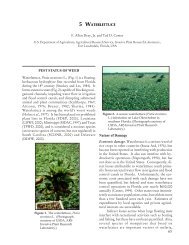

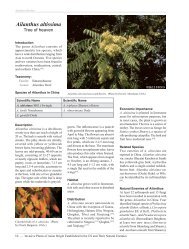
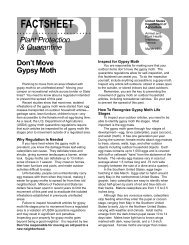
![A Guide to the Control and Management of Invasive Phragmites [PDF]](https://img.yumpu.com/27321025/1/190x190/a-guide-to-the-control-and-management-of-invasive-phragmites-pdf.jpg?quality=85)
